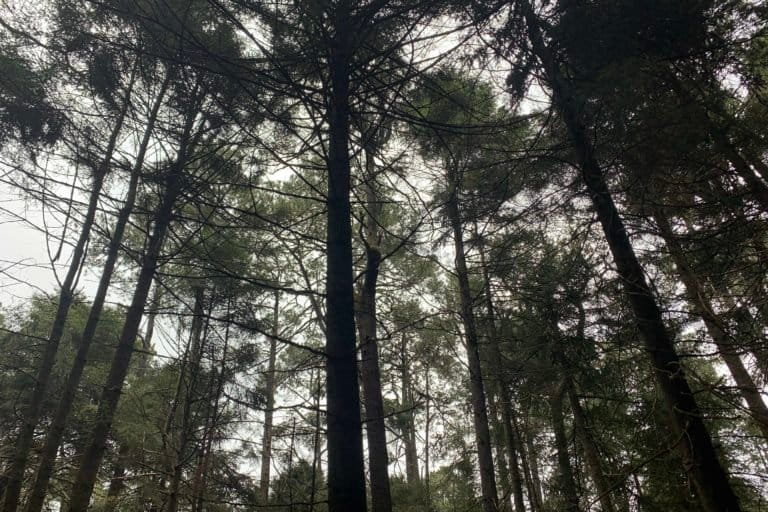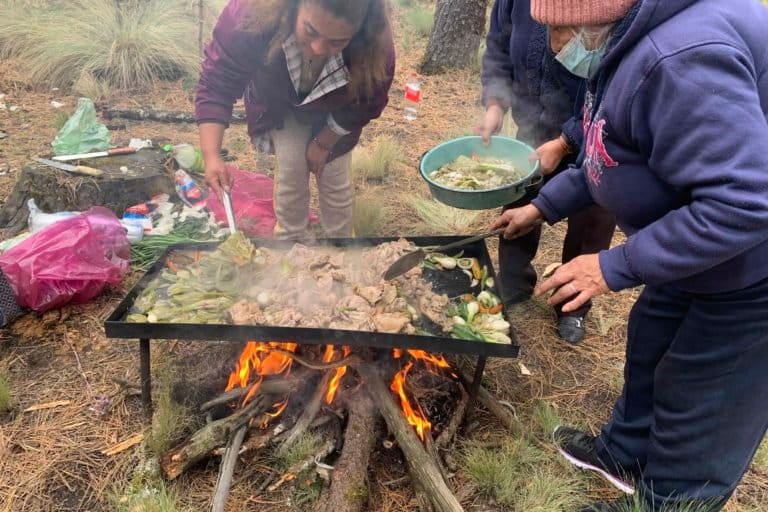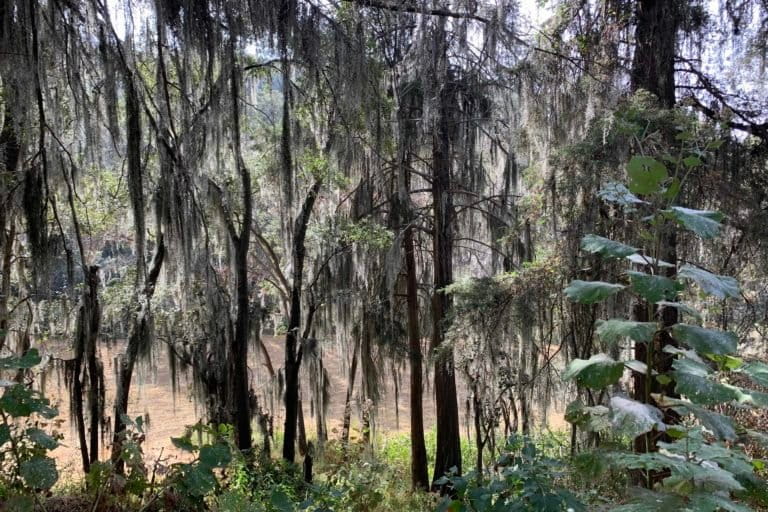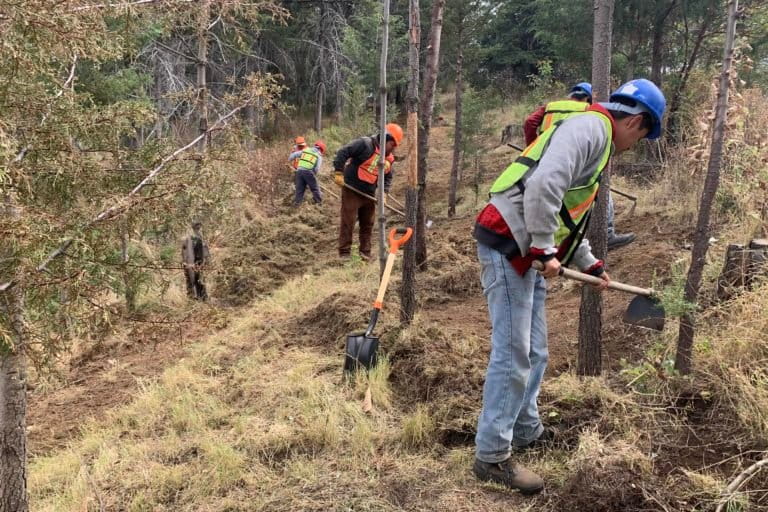- About an hour and a half from Mexico City, communities in the municipalities of Texcoco and Tepetlaoxtoc de Hidalgo use forest management as a tool to sustain themselves and conserve their forests.
- Their sustainable timber-harvesting activity is authorized by the forestry agency, and they complement it with other activities such as collecting edible mushrooms and medicinal plants, or ecotourism.
- These ejidos, or communally managed lands, are also diligently managed to minimize fire risk, through initiative such as pruning and creating firebreaks.
- “We make use of the forest, yes, but we take care of it,” says one of the community members. “This is for everyone: for the youth to come, for the environment.”
It’s just before noon on a Saturday in the forest shared by the San Juan Totolapan ejido, or communal farming village, in central Mexico. Not a single bird can be heard in the forest, at least for the moment. What can be heard now, however, are the sounds of chainsaws and machetes as they cut into tree branches, and people shouting to each other. But here, these sounds don’t signal illegal logging activity underway.
No one’s destroying the forest here. In fact, quite the opposite is happening.
About 30 ejido members, or ejidatarios, along with their children and grandchildren, spend much of their weekend doing what they call faena, or various tasks to benefit their forest and the community. On this particular day, they’re pruning the trees.
“We prune them so that they grow straighter and faster, and so that the trunk thickens,” says Gregorio Martínez Sandoval, an ejidatario who is also the head of the surveillance brigade for the community forest in San Juan Totolapan in the municipality of Tepetlaoxtoc de Hidalgo, in the state of México.

In this community, about an hour and a half from Mexico City, the ejidatarios organize themselves into brigades to do various types of work to keep their forest healthy. This includes pruning, cutting tall grasses, and creating firebreaks. They also carry out surveillance rounds to prevent undercover logging.
Every weekend, a group of 30 people enters the forest to work. The ejido has hired four technical advisers who indicate where in the forest they should work.
Maintaining this forest, in addition to the other forests in this region close to the metropolitan area, is a laudable act, according to Aurelio Bastida, a professor at Chapingo Autonomous University who specializes in silvicultural systems and forestry production.
“In a place close to an area as anthropized” — transformed by humans — “as the metropolitan area, everything that can be done to conserve the forests [which are] the places where water is captured and where forest management is done that allows there to be young trees, which capture the most carbon, is very important, and not just for these communities,” Bastida says.

An investment in the community, thanks to the forest
The San Juan Totolapan ejido has 99 members who collectively manage 746 hectares (1,843 acres) of forest. Pine trees (Pinus sylvestris) and oyamel fir trees (Abies religiosa) abound here, and the local wildlife includes bobcats (Lynx rufus).
For 20 years, the community members have managed their own forest. To achieve this, they have a forest-use program in place that allows them to produce timber in a way that’s sustainable and authorized by the Mexican Secretariat of Environment and Natural Resources (SEMARNAT).
The program establishes how much timber they can extract each year and from which areas, based on recommendations from the technical advisers. It also outlines reforestation plans for areas where timber harvesting is done.
“Right now, the program has just ended after a decade, and we are in the technical studies [phase] for the next [program],” said Víctor López, president of the ejido’s commission.

The revenue from the sale of the timber is distributed among the ejidatarios, with a portion also allocated for buying the materials needed to care for the forest and invest in the community.
“Streets were paved, the elementary school was improved, [and] the ejido’s assembly hall was constructed. If there is a death, that is where the [money] comes from to help with the funeral, and the same goes for any emergency that any ejidatario has,” says Javier González Chávez, one of the technical advisers hired by the ejido to help with forest management.
“We reforest where there is a need, although plants are only planted in necessary cases because we prefer that the forest would regenerate on its own, [by] seeds falling and new trees being born,” said López, the ejido commission president.
To this end the community also carries out a kind of forestry housekeeping process: After cutting down a tree with the permission of SEMARNAT, they clear away any remaining residue and leave the area clean. This way, the soil is in good condition for any new seeds to take root and grow.
It hasn’t been easy for the community members to manage their land. J. Carmen Ayala Sosa, a forestry expert from Chapingo Autonomous University, says that in addition to having to get permission for various activities, navigating the bureaucracy, they also have to contend with people who don’t understand how forest use works. “The people from outside [of the community] denounce them because they believe that they are using up the forest. They don’t know that they are authorized to make use of it,” Ayala Sosa says.
The ejidatarios’ efforts in San Juan Totolapan have been fruitful: their community forest looks lush and cared for. Unlike neighboring communities that also carry out forest management, they don’t practice ecotourism here.

Of mushrooms and medicinal plants
“Up to here!” shouts technical adviser González Chávez to indicate how the trees should be pruned. The next day, a Sunday, the trees in another section of the forest will be pruned.
Nearby, five ejidatarias begin to prepare food by starting a fire. They put onions, chili peppers, nopales (chunks of prickly pear cactus) and meat fall onto a griddle, and place tortillas on the side.
“We do not come to do the [physical] work because it is heavy, but we pay someone to do the work that we need done,” says María López García, one of the ejidatarias. “Of course, we participate in the assemblies. We come and get informed about what is needed so that our forest [stays] well, and we participate in decisions about what is going to be done.”
González Chávez later describes López García as one of the most active participants and seasoned people in the assembly meetings. “She gives her opinion and asks questions. She has already been asked to be president of the commission, but she says no — because there is still a lot of sexism — but I think that she will warm up to [the task] soon,” González Chávez says.

As they prepare the food, the women talk about the benefits they receive from the community forest. In addition to oxygen, water, and timber, it’s also a source of food and medicinal plants.
During the rainy season, in June and July, community members enter the forest to collect edible mushrooms. Some then sell them in the nearby city of Texcoco; others trade them for other goods. “They exchange them for cheese, meat, or whatever they need,” López García says.
The forest is also like a pharmacy for the ejidatarios. Here, they find medicinal plants that they use to alleviate coughs, headaches, and stomachaches.
“Here we have mullein [Verbascum thapsus], the air plant [Kalanchoe pinnata], jarilla [Larrea cuneifolia]. Our ancestors knew and used even more plants,” says Guadalupe Martínez, an ejidataria. “That is another reason it is important to take care of these places: because they provide us with these plants to cure ourselves.”
The forest, says fellow ejidataria María Esteban, is like water: “It gives us life. It gives us so many things. As long as we take care of it, we will have oxygen and all its benefits. If we stop doing so, we will end up with nothing.”

An offering to the spirits
“Open your arms with your palms facing backward so that the wind carries all the bad [things] away,” says an ejidatario at an overlook spot at El Cedral Recreational Park in the San Pablo Ixayoc ejido. This ejido is in Texcoco, about 45 minutes from San Juan Totolapan.
The community’s 125 ejidatarios manage 896 hectares (2,214 acres) of a forest that includes netleaf oak trees (Quercus rugosa), oyamel fir trees and pine trees. They’ve set aside 42 hectares (104 acres) to create an ecotourism park, an economic alternative to timber extraction.
Spanish moss, a plant that grows in humid places in temperate and tropical regions, hangs from many of the trees in El Cedral. These grayish strips lend an air of mystery to the forest, making it an ideal setting to listen to the community members’ legends about the fantastic beings they say are found in this forest.

Community members say that spirits known as chaneques live among these trees. They leave alcohol and food as offerings meant to thank the spirits for allowing them to drink water from their spring.
The community members say that if any visitor to the park dares to take any of the clay jugs that are part of these offerings, the spirits will haunt that person every night.
Just like in San Juan Totolapan, the ejidatarios in San Pablo Ixayoc are benefiting from their forest under a management program authorized by SEMARNAT. They extract only the timber that’s allowed under the program. “After that, the areas are left to recuperate, if that is possible naturally; if not, they are reforested. We just reforested with 9,500 pine trees,” says Armando Hidalgo, president of the San Pablo Ixayoc ejido’s commission.

A union of ejidos in the forest
San Pablo Ixayoc, Santa Catarina del Monte, Santa María Nativitas, Tequexquináhuac, San Dieguito Xochimanga, and San Miguel Tlaixpan form a union of ejidos whose territories make up part of the forested slopes of Mount Tláloc, a dormant volcano. The highest pre-Hispanic ceremonial center in Mesoamerica is located on this mountain, at an elevation of 4,120 meters (13,520 feet).
Every month, representatives from each of the ejidos in the union meet to evaluate the work that’s been done in their forests and determine what else is needed to maintain them. They discuss surveillance, tourism control, fires, and illegal logging.
Regulating tourism is important, they say, because not all visitors are conscious of the fact that the forest must be taken care of. “They come with their four-wheelers and they want to pass through everywhere, because they say that the forest [belongs to] everyone. But that is not so. The forest has owners, although it is an ecosystem that provides benefits to everyone,” says Ayala Sosa, Chapingo Autonomous University professor.
“Here in San Pablo, we take good care of our forest,” says Hidalgo, the San Pablo Ixayoc ejido commission president. “Right now, we are placing hoses to irrigate, because the drought was affecting us. An infestation was being created. We did [forest] sanitation work.”
Álvaro Monsalvo Espejel, a technical adviser for the ejido, says a bark beetle infestation affected 3-4 hectares (7-10 acres) of the forest. The insects burrow into the bark, creating grooves that prevent water and nutrients from being dispersed.

In addition to infestations, fires are another problem facing the forests.
For this reason, the San Pablo Ixayoc ejidatarios maintain firebreaks in their forest. These gaps of about 5 meters (16 feet) are meant to prevent fires from spreading and make it easier to extinguish them.
“There will be 400 meters [1,310 ft] of firebreaks, and the adjacent trees will be pruned to prevent a fire from rising up high in the event of an accident,” says Artemio Pineda, an ejidatario and member of the commission.
Pineda cites a fire that broke out in a neighboring community four years ago. “Here, we managed to put it out, thanks to the work that is done in the forest. In fact, we helped them to extinguish the fire in that community [Catarina] and for the individual whose land was burning,” he says.

The work done by the communities in their forests is arduous and time-consuming.
“Sometimes people don’t understand it. They think that we are logging without permission, but no; we have everything regulated,” says Andrés Espejel, an ejidatario in San Juan Totolapan. “Also, the forest is cleaned because of the [bark beetle] infestation. We do not cut just like that. We make use of the forest, yes, but we take care of it. [We do this] not just for ourselves. This is for everyone: for the youth to come, for the environment.”
To ensure that the youngest community members learn to take care of the forest, the ejidatarios of San Juan Totolapan take their children and grandchildren along to help with the work of maintaining the forest. On this Saturday, the children are busy pruning the trees.
For the youngest community members, it’s less of a chore and more of a game: when a branch needs pruning that’s too high, they jump to reach it, pull to lower it, and one child takes charge of cutting it. They challenge each other to see who can jump the highest. They’re learning that the forest is intertwined with work, unity, coexistence, and life.
Banner image: Every weekend, the ejidatarios work to maintain their forest. Image by Andrea Vega.
This story was reported by Mongabay’s Latam team and first published here on our Latam site on Feb. 15, 2022.
